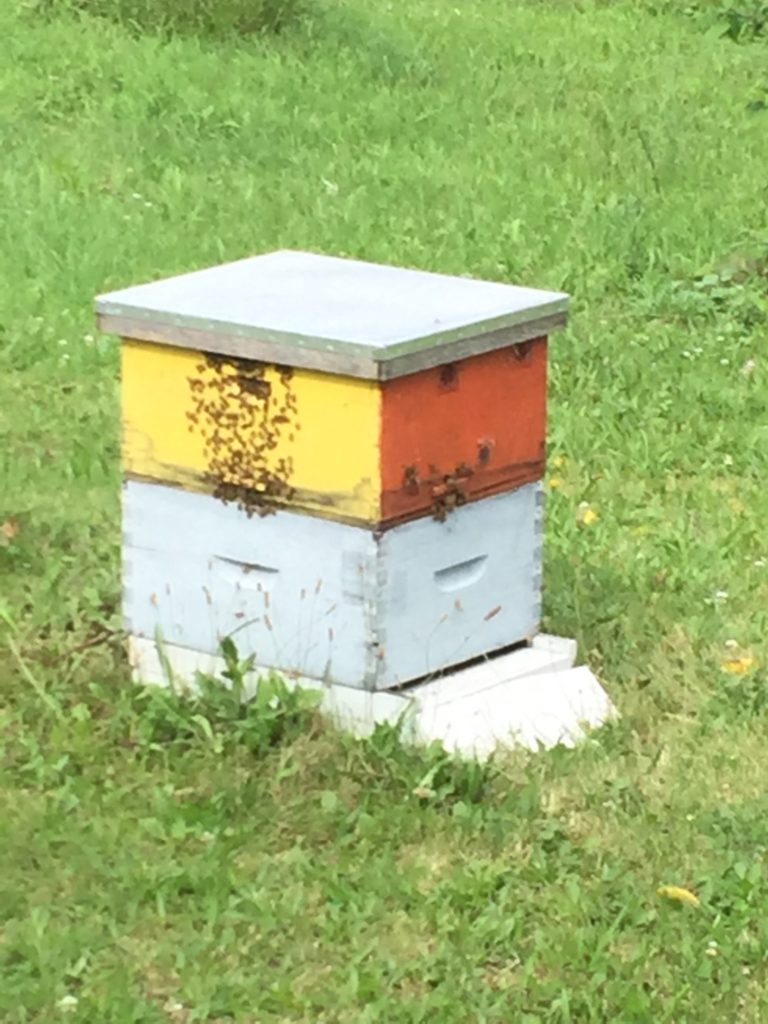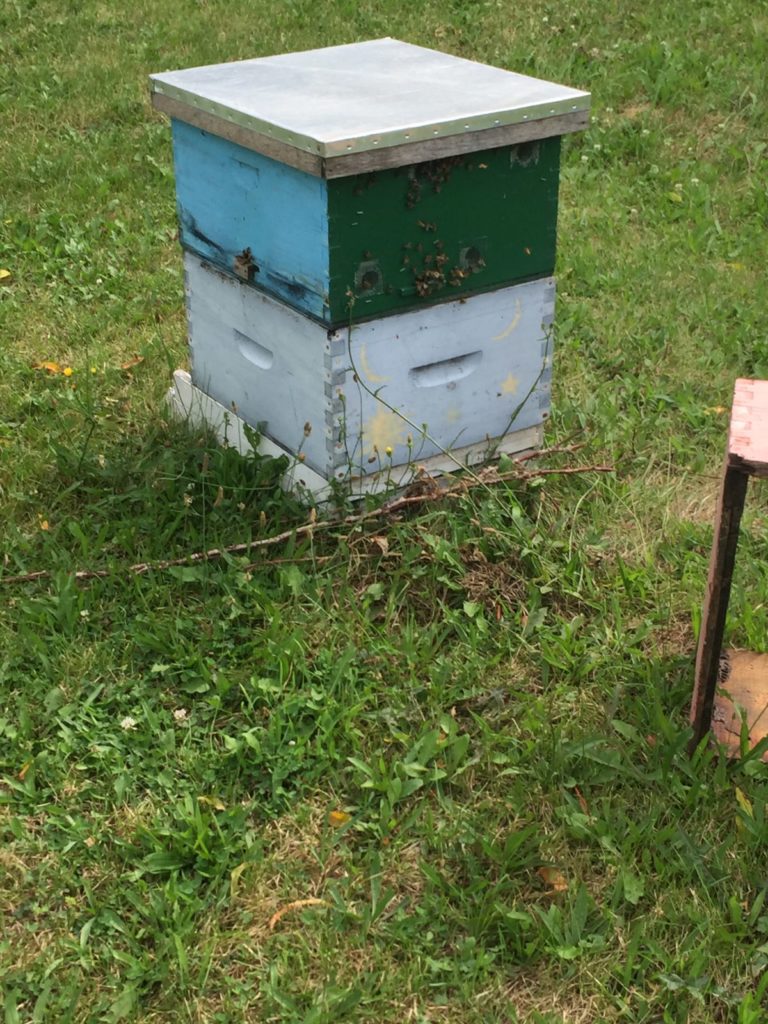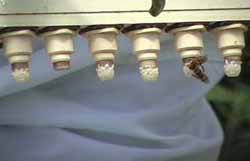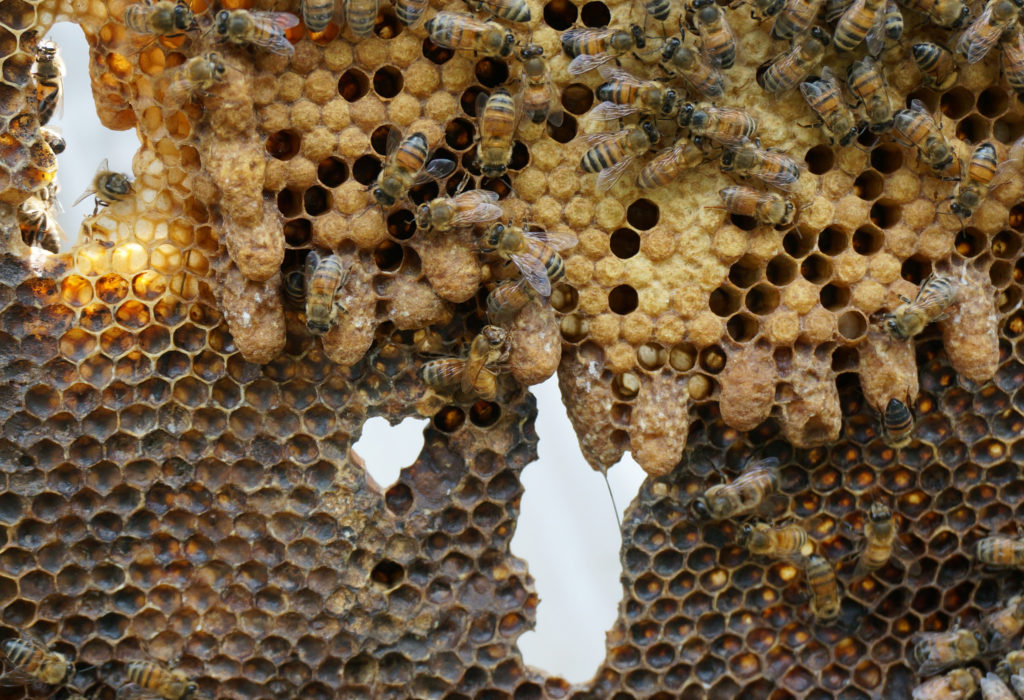Bee Lines: Queen Castles
by Sam Hall –

 A queen castle is a ten frame super that has been divided into four sections that each holds two deep frames. There is an entrance on each side of the super so that each section has it’s own entrance for the bees in that section to come and go. To help with orientation for the bees and Queens I have painted each side of the super a different color.
A queen castle is a ten frame super that has been divided into four sections that each holds two deep frames. There is an entrance on each side of the super so that each section has it’s own entrance for the bees in that section to come and go. To help with orientation for the bees and Queens I have painted each side of the super a different color.
Orientation is where a Queen or as any bee first exits a hive after emerging from their birth cell or after their hive has been moved to at a new location, they do what a human does in a new neighborhood. They come out look around at the surroundings noting nearby trees, buildings, ponds and of course look back at just where and what they came out of. When they look back at the queen castle they will note the color of the wall of the castle that they exited from so they can return to the same entrance/exit. This endeavor is also aided by the Queen’s pheromones which all bees in a colony recognize and will be present at that entrance. While it is an oversimplification to call a pheromone a scent it could be likened to that for this purpose.
This year for the first time in quite a while I decided to raise a few queens. Using a Nicot box I was  able to have the queen I had decided to breed from lay eggs into small plastic queen cups which are about half the size of a small thimble. Those cups I then transferred into a “cell building” colony. A cell building colony is one that I have made queenless for a few days beforehand so they will be anxious to start the queen rearing process. Putting the queen cups into the cell builder the workers will select which of the eggs they will make into queens. I put eight eggs in cups into the cell builder and they selected six to make into queens. The other two they ignored which meant if those eggs hatched the bees did not feed or take care of the larvae and they perished.
able to have the queen I had decided to breed from lay eggs into small plastic queen cups which are about half the size of a small thimble. Those cups I then transferred into a “cell building” colony. A cell building colony is one that I have made queenless for a few days beforehand so they will be anxious to start the queen rearing process. Putting the queen cups into the cell builder the workers will select which of the eggs they will make into queens. I put eight eggs in cups into the cell builder and they selected six to make into queens. The other two they ignored which meant if those eggs hatched the bees did not feed or take care of the larvae and they perished.

The bees elongated the cells of the selected six into full queen cells and during the larval stage fed them amongst other things Royal Jelly. A book could be written about Royal Jelly and probably has been but suffice it to say while all worker bees in their development are fed some Royal Jelly the queens at this stage are fed a lot more.
Eventually the queen cells are sealed and the larvae goes thru the metamorphous into an adult Queen. After the cells were sealed I put cell protectors up over each of the cells. These protectors have a removable bottom which you want to be sure is closed at this point. The reason for this is that the first queen to emerge will sting to death the other queens who have not emerged and are still in their cells.
Then I took two frames of some brood and honey with attached nurse bees from four of my stronger colonies and put them into the four compartments of the queen castle. I then took four of the queen cells in their protectors, opened up the bottoms so the queen could emerge when she exited the cell and place them into the four compartments of the queen castle.
I left one of the queen cells in the cell builder as that colony was queenless and the last one I placed in a four frame nuc that was queenless. It is sixteen days from the laying of the egg until a queen emerges from the cell. In my case this was July 12th. I have found it is not necessarily exactly sixteen days but can vary to almost up to 24 hours.
I now have six vibrant queens four of which will be used to head colonies in double nuc boxes for over the winter. The remaining two are already heading up full colonies. They are small queens and their abdomens are all black which probably means they are primarily Russian or Caucasian but definitely from Eastern Europe.
Being local queens which emerged after the summer solstice their chances of surviving a western New York winter are greatly enhanced. I highly recommend raising your own queens. If you only want one or two or three an excellent and simple method is the Miller method which I believe can be found on line.
Sam Hall is a Western NY beekeeper who first worked bees as a child growing up on a ‘dirt farm’ in Allegany County, NY. He has kept bees for most of his adult life and believes that his mistakes ‘far outnumber his successes.’